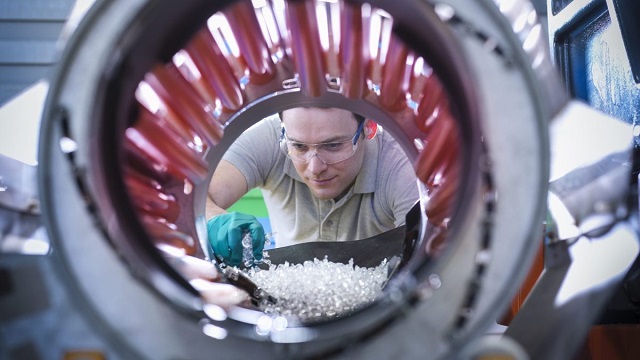Alberta
How natural gas supports one of Canada’s largest manufacturing sectors

Worker inspecting parts from plastic injection moulding machine in plastics factory. Getty Images photo
From the Canadian Energy Centre
‘When you think about the demand for more sustainable outcomes: clean air, clean water, clean energy, safe, nutritious, abundant food and electric vehicles, that’s more and more and more chemistry’
Canada’s chemical industry sold a record $72.7 billion of product last year amid recovery from COVID-19 and strong consumer demand, according to the Chemistry Industry Association of Canada (CIAC).
Natural gas is a key input to the chemistry sector, the broad term that refers to manufacturing a myriad of products used in everyday items from plastics to agriculture and pharmaceuticals.
“Chemistry products go into 95 per cent of finished goods. It’s an important sector,” says CIAC president Bob Masterson.
“It’s a sector that can grow as long as we fancy improving our lives and building a better world for tomorrow.”
Chemicals in Canada
Canada’s chemistry industry is the country’s fourth largest manufacturing sector by value of sales after food ($147 billion), transportation equipment ($119 billion), and petroleum/coal products ($118 billion).
It is primarily centered in Ontario, Alberta and Quebec.
The CIAC publishes an annual report on the sector’s activity using Statistics Canada data, separated into two categories: chemicals overall, and industrial chemicals.
Chemicals overall includes manufacturing of soaps, cleaning compounds, paints, coatings and adhesives, pesticides and fertilizers, pharmaceuticals, rubbers and synthetic fibres, and basic chemicals.
Industrial chemicals refers to the manufacturing of intermediate products used as inputs by industries including plastic and rubber products, forest products, transportation equipment, clothing, perfume and cosmetics, construction and pharmaceuticals.
Global Growth
According to Vantage Market Research, the global chemical market was valued at US$584 billion in 2022. It’s expected to grow by more than 55 per cent in the coming years to reach US$917 billion by 2030.
This isn’t just driven population growth, Masterson says.
“When you think about the demand for more sustainable outcomes: clean air, clean water, clean energy, safe, nutritious, abundant food and electric vehicles, that’s more and more and more chemistry,” he says.
“Some of the predictions are that the volumes of chemistry will double in the next 20 years. Canada and Alberta in particular are exceptionally well positioned to help meet future market demand for these products. The demand is not going away. There’s no question about that.”
Jobs
In 2022, Canada’s chemicals sector directly employed 90,800 people, or approximately the population size of Sudbury, Ontario. The industry paid about $7 billion in salary and wages.
That’s the direct impact of employment in the chemistry sector, but the CIAC estimates the full benefit to Canadians to be much higher as a result of indirect economic activity it supports.
CIAC estimates that every job in Canada’s chemistry sector creates another five indirect jobs in other parts of the economy. This means the sector supported 454,000 jobs across Canada in 2022.
Industrial chemicals alone directly employed 17,100 people and indirectly supported 85,600 jobs in the broader Canadian economy last year, the CIAC says.
Rising Trade
At a value of $72.7 billion, Canada’s overall chemical industry sales were their highest ever in 2022 – a 30 per cent increase compared to 2019, prior to the COVID-19 pandemic.
Industrial chemicals sales reached a record $34.2 billion, a 32 per cent increase compared to 2019.
Exports also increased last year, rising to a value of $52.8 billion compared to $45.9 billion in 2021. Of that, the sector exported $24.8 billion of industrial chemicals, up from $22.5 billion the previous year.
The United States is Canada’s main customer for chemical exports, representing 76 per cent of exports or $40.1 billion in 2022. The next largest export markets are China ($1.86 billion), the Netherlands ($1.7 billion), and the United Kingdom ($1.1 billion).
The Canada Advantage
Canada has distinct advantages as a chemical manufacturer and exporter including growing access to global markets, CIAC says.
In Alberta, the main advantage is access to low-cost natural gas resources – specifically valuable natural gas liquids like ethane, propane and butane.
“The rich abundance of natural gas liquids that come out of the ground when we drill for natural gas let Alberta be a low-cost chemistry producer despite being pretty much the only large chemistry industry worldwide that’s not on tidewater,” Masterson says.
Responsible Care
Since 1985, Canada’s chemistry industry has operated under an initiative called Responsible Care that encourages companies to innovate for safer and greener products.
CIAC reports that Responsible Care is now practiced in 73 countries and by 96 of the 100 largest chemical producers in the world.
Since 2005, CIAC members have reduced CO2 equivalent emissions by 13 per cent; reduced sulphur dioxide emissions by 94 per cent, and virtually eliminated large scale safety incidents. Since 2012, CIAC members have also reduced net water consumption by 13 per cent.
“We’re not standing in place,” Masterson says.
Alberta
Red Deer Justice Centre Grand Opening: Building access to justice for Albertans

The new Red Deer Justice Centre will help Albertans resolve their legal matters faster.
Albertans deserve to have access to a fair, accessible and transparent justice system. Modernizing Alberta’s courthouse infrastructure will help make sure Alberta’s justice system runs efficiently and meets the needs of the province’s growing population.
Alberta’s government has invested $191 million to build the new Red Deer Justice Centre, increasing the number of courtrooms from eight to 12, allowing more cases to be heard at one time.
“Modern, accessible courthouses and streamlined services not only strengthen our justice
system – they build safer, stronger communities across the province. Investing in the new Red Deer Justice Centre is vital to helping our justice system operate more efficiently, and will give people in Red Deer and across central Alberta better access to justice.”

Government of Alberta and Judiciary representatives with special guests at the Red Deer Justice Centre plaque unveiling event April 22, 2025.
On March 3, all court services in Red Deer began operating out of the new justice centre. The new justice centre has 12 courtrooms fully built and equipped with video-conference equipment to allow witnesses to attend remotely if they cannot travel, and vulnerable witnesses to testify from outside the courtroom.
The new justice centre also has spaces for people taking alternative approaches to the traditional courtroom trial process, with the three new suites for judicial dispute resolution services, a specific suite for other dispute resolution services, such as family mediation and civil mediation, and a new Indigenous courtroom with dedicated venting for smudging purposes.
“We are very excited about this new courthouse for central Alberta. Investing in the places where people seek justice shows respect for the rights of all Albertans. The Red Deer Justice Centre fills a significant infrastructure need for this rapidly growing part of the province. It is also an important symbol of the rule of law, meaning that none of us are above the law, and there is an independent judiciary to decide disputes. This is essential for a healthy functioning democracy.”
“Public safety and access to justice go hand in hand. With this investment in the new Red Deer Justice Centre, Alberta’s government is ensuring that communities are safer, legal matters are resolved more efficiently and all Albertans get the support they need.”
“This state-of-the-art facility will serve the people of Red Deer and surrounding communities for generations. Our team at Infrastructure is incredibly proud of the work done to plan, design and build this project. I want to thank everyone, at all levels, who helped make this project a reality.”
Budget 2025 is meeting the challenge faced by Alberta with continued investments in education and health, lower taxes for families and a focus on the economy.

Quick facts
- The new Red Deer Justice Centre is 312,000 sq ft (29,000 m2). (The old courthouse is 98,780 sq ft (9,177 m2)).
- The approved project funding for the Red Deer Justice Centre is about $191 million.
Alberta
CPP another example of Albertans’ outsized contribution to Canada

From the Fraser Institute
By Tegan Hill
Amid the economic uncertainty fuelled by Trump’s trade war, its perhaps more important than ever to understand Alberta’s crucial role in the federation and its outsized contribution to programs such as the Canada Pension Plan (CPP).
From 1981 to 2022, Albertan’s net contribution to the CPP—meaning the amount Albertans paid into the program over and above what retirees in Alberta received in CPP payments—was $53.6 billion. In 2022 (the latest year of available data), Albertans’ net contribution to the CPP was $3.0 billion.
During that same period (1981 to 2022), British Columbia was the only other province where residents paid more into the CPP than retirees received in benefits—and Alberta’s contribution was six times greater than B.C.’s contribution. Put differently, residents in seven out of the nine provinces that participate in the CPP (Quebec has its own plan) receive more back in benefits than they contribute to the program.
Albertans pay an outsized contribution to federal and national programs, including the CPP because of the province’s relatively high rates of employment, higher average incomes and younger population (i.e. more workers pay into the CPP and less retirees take from it).
Put simply, Albertan workers have been helping fund the retirement of Canadians from coast to coast for decades, and without Alberta, the CPP would look much different.
How different?
If Alberta withdrew from the CPP and established its own standalone provincial pension plan, Alberta workers would receive the same retirement benefits but at a lower cost (i.e. lower CPP contribution rate deducted from our paycheques) than other Canadians, while the contribution rate—essentially the CPP tax rate—to fund the program would likely need to increase for the rest of the country to maintain the same benefits.
And given current demographic projections, immigration patterns and Alberta’s long history of leading the provinces in economic growth, Albertan workers will likely continue to pay more into the CPP than Albertan retirees get back from it.
Therefore, considering Alberta’s crucial role in national programs, the next federal government—whoever that may be—should undo and prevent policies that negatively impact the province and Albertans ability to contribute to Canada. Think of Bill C-69 (which imposes complex, uncertain and onerous review requirements on major energy projects), Bill C-48 (which bans large oil tankers off B.C.’s northern coast and limits access to Asian markets), an arbitrary cap on oil and gas emissions, numerous other “net-zero” targets, and so on.
Canada faces serious economic challenges, including a trade war with the United States. In times like this, it’s important to remember Alberta’s crucial role in the federation and the outsized contributions of Alberta workers to the wellbeing of Canadians across the country.
-

 2025 Federal Election10 hours ago
2025 Federal Election10 hours agoStudy links B.C.’s drug policies to more overdoses, but researchers urge caution
-

 Business1 day ago
Business1 day agoTrump: China’s tariffs to “come down substantially” after negotiations with Xi
-

 conflict1 day ago
conflict1 day agoMarco Rubio says US could soon ‘move on’ from Ukraine conflict: ‘This is not our war’
-

 Business1 day ago
Business1 day agoChinese firm unveils palm-based biometric ID payments, sparking fresh privacy concerns
-

 2025 Federal Election2 days ago
2025 Federal Election2 days agoMark Carney Wants You to Forget He Clearly Opposes the Development and Export of Canada’s Natural Resources
-

 2025 Federal Election1 day ago
2025 Federal Election1 day agoPolice Associations Endorse Conservatives. Poilievre Will Shut Down Tent Cities
-

 Alberta1 day ago
Alberta1 day agoRed Deer Justice Centre Grand Opening: Building access to justice for Albertans
-

 2025 Federal Election12 hours ago
2025 Federal Election12 hours agoWhen it comes to pipelines, Carney’s words flow both ways





